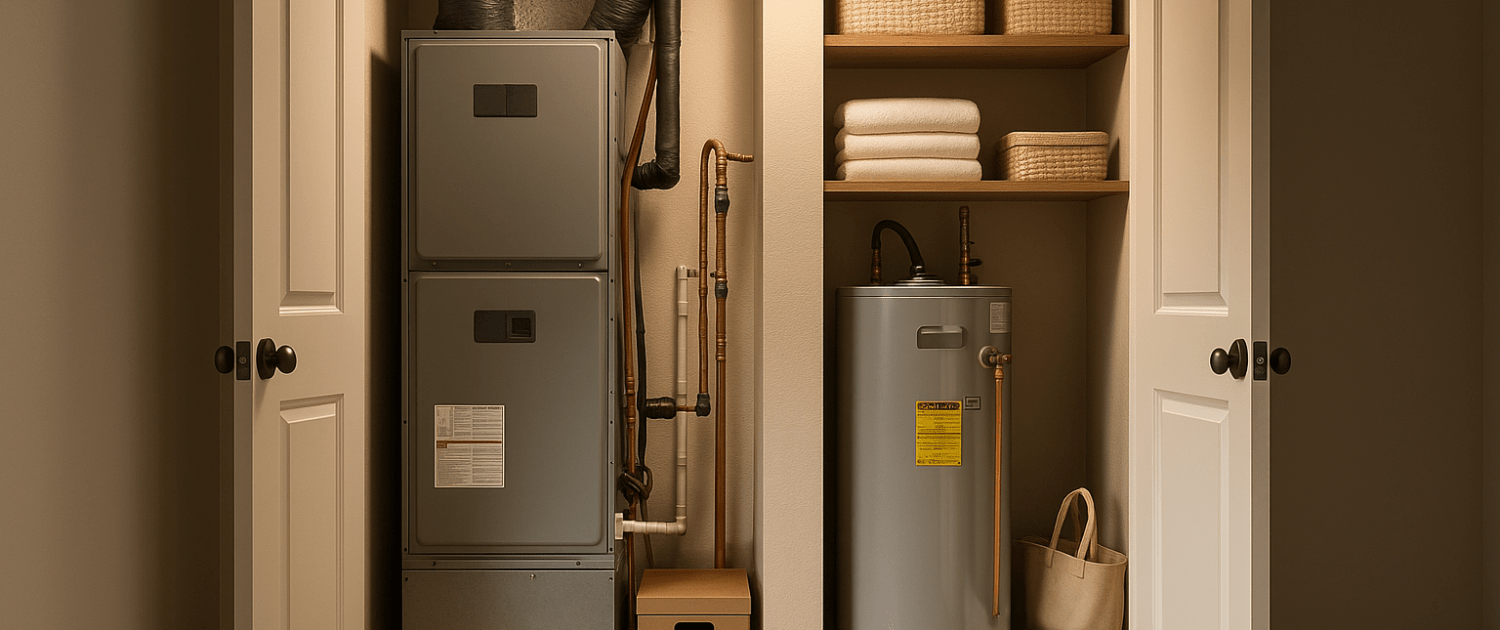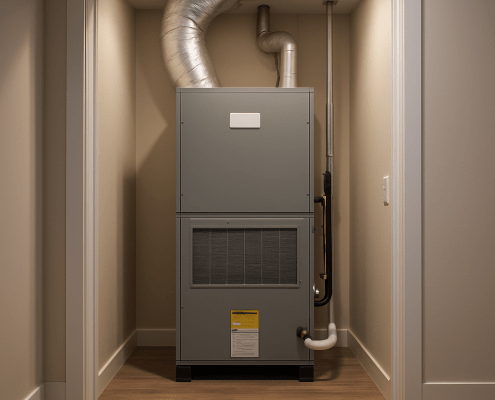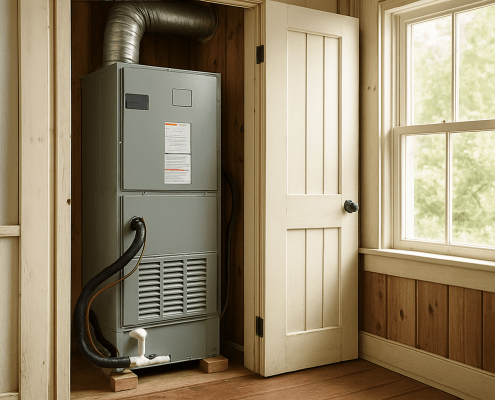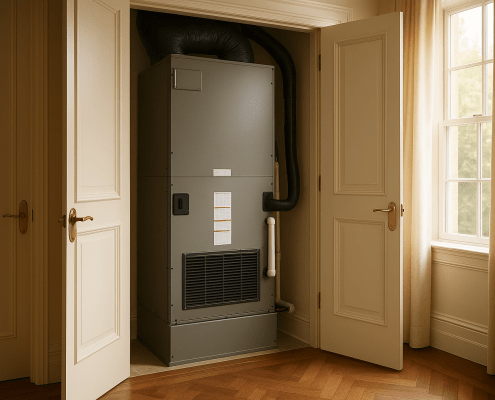How to Test and Replace a Central AC Capacitor
Steven E / Wednesday July 2, 2025
If your central air conditioning system is having trouble starting up, struggling to cool the house, or making strange buzzing noises, the culprit could be the capacitor. Luckily, testing and replacing a central AC capacitor is a straightforward DIY job that many homeowners can handle safely with the right tools and precautions.
The information in this article may not apply to your specific appliance model. We recommend consulting your manufacturer’s documentation or contact us with any questions.
What Is a Central AC Capacitor?
A capacitor is a small, cylindrical or oval-shaped component located in the outdoor condenser unit. It stores and releases energy to help start and run motors, usually the compressor and the fan.
There are two main types of capacitors found in central AC units:
- Start Capacitor: Delivers a high-voltage boost to start the compressor.
- Run Capacitor: Provides continuous voltage to keep the compressor and fan motor running smoothly.
Many systems use a dual-run capacitor, which powers both the fan and compressor in one housing, with three labeled terminals: C (Common), FAN, and HERM (compressor).
Signs of a Failing AC Capacitor
Before jumping into testing or replacing the capacitor, look for these common signs that it’s failing or has already failed:
- AC won’t start or struggles to start
- Humming noise from the condenser unit
- Fan starts late or not at all
- Compressor cuts in and out
- AC blows warm air
- System trips the breaker
- Bulging or leaking capacitor
If your system shows any of these symptoms, it’s a good idea to test the capacitor before replacing other components.
Safety First
Before performing any testing or repairs, shut off power to the AC unit at the main circuit breaker. Capacitors can hold a dangerous electrical charge even after power is off, so proper safety steps are critical. You’ll also want to wear safety glasses, insulated gloves and rubber-soled shoes.
Tools and Materials You’ll Need
Gather these items before starting the job:
- Multimeter with capacitance (µF) setting
- Insulated screwdriver
- Nut driver or socket set
- Needle-nose pliers or wire cutters
- Replacement capacitor
- Permanent marker or masking tape for labeling wires
- Electrical tape (optional)
Shut Off Power to the AC Unit
- Go to your breaker box and switch off the circuit controlling your air conditioner.
- For added safety, pull the disconnect located outside near the condenser unit.
- Use a non-contact voltage tester to double-check that no power is flowing to the unit.
Always verify power is completely off before opening the unit.
Access the Capacitor
- Use a nut driver or screwdriver to remove the side panel on the condenser unit. This usually involves a few screws along the top and side.
- Locate the capacitor, it’s usually mounted to the side of the housing and shaped like a silver can (round or oval).
- Before touching it, take a photo of the wire connections or label them with tape and a marker. You’ll need to reattach them in the exact same order.
Step 3: Discharge the Capacitor
Even with power off, capacitors can retain a dangerous charge. You must safely discharge it before removing or testing it.
- Take an insulated screwdriver and place the blade across the terminals.
- Touch one terminal with the tip and then rotate the screwdriver to bridge it to the next.
- Repeat for all terminal combinations (C to FAN, C to HERM).
- You may see a small spark; that’s normal.
Discharging the capacitor is essential for your safety.
Step 4: Remove the Capacitor
- Use needle-nose pliers to carefully pull the wire terminals off the capacitor tabs. Twist gently to loosen tight connectors.
- Remove the mounting strap or bracket and slide the capacitor out.
- Examine the capacitor for physical damage, including bulging top or sides, oil or fluid leaking, and burn marks. Any of these signs confirm that it needs to be replaced.
Test the Capacitor with a Multimeter
Set your multimeter to the capacitance setting (µF).
- Connect one probe to the C terminal, and the other to the FAN terminal.
- Read the value and compare it to the manufacturer’s label on the capacitor.
- Repeat for C to HERM.
The readings should be within ±10% of the labeled value. If either reading is outside this range or if the multimeter shows OL (open loop), the capacitor is faulty and needs replacement.
Install the New Capacitor
- Position the new capacitor in the bracket or mount and secure it with screws or clips.
- Reattach the wires using your photo or labeled tape as a guide.
- Make sure terminals are pushed on snugly and no wires are loose.
- Use electrical tape to bundle and organize wires if necessary.
- Check that no wires are touching the metal housing or fan blades.
Close the Unit and Restore Power
- Replace the side panel and tighten all screws.
- Turn the circuit breaker and disconnect switch back on.
- Set your thermostat to “Cool” and lower the temperature to trigger the AC.
Let the system run for 10–15 minutes and observe for any problems. If everything runs smoothly, your new capacitor is doing its job.
Extra Tips for Success
- Always keep an extra capacitor on hand: They’re inexpensive and common failure points.
- Label wires before removal to avoid confusion during reinstallation.
- Keep the work area dry to avoid slips and electrical hazards.
- Store the old capacitor safely until it can be properly disposed of at an electronics recycling center.
Where To Find Us
If you need any replacement parts for your appliances, you can enter your model number at AppliancePartsPros.com to locate and order them quickly. Most orders arrive in just two business days, and we have tons of great information in our repair help section and YouTube videos to help you troubleshoot.
Stay connected with the latest DIY tips, tutorial videos, and repair guides by following us on Facebook, Instagram, and Twitter. We love hearing about your repair stories and successes. If you need more help or want personalized guidance, feel free to reach out. We’re ready to help you take on your next project with confidence!
With nearly a decade of experience in providing top-notch customer service regarding appliance parts and repair, Steven enjoys sharing practical advice, troubleshooting tips, and interesting information to help readers stay informed.





